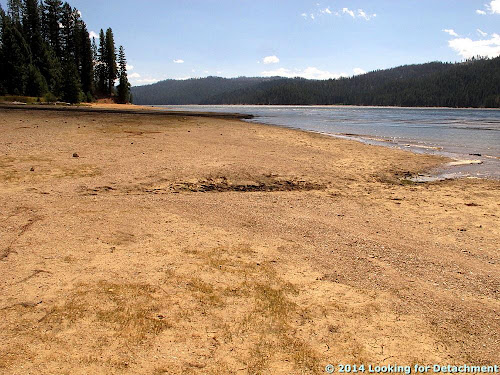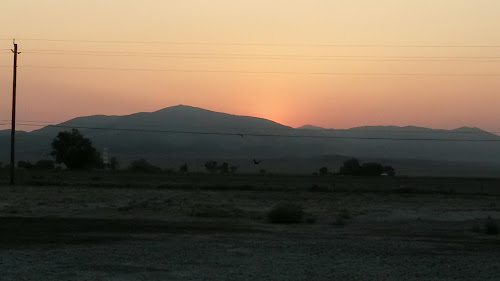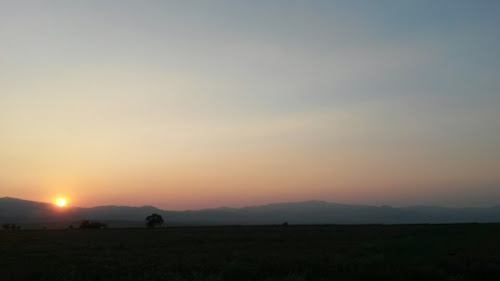After checking out the old alignment, I thought about turning around and going back to Toulon to get on the freeway, then decided to go on toward the old site of Trinity, where U.S. 95 south to Fallon meets I-80. Go forward, not back! To do this, I drove southwest on an easy portion of what turned out to be a long, tedious, and very rocky section of powerline road.
Near the top of the first rise, the road narrowed and turned rocky and then went into the first of a series of sideways excursions across several large and small washes coming south out of the south Trinity Range. Near the bottom of the first of these washes, I pushed my way through a small silt hole (I was already in 4WD in order to go slower over the sharp volcanic rocks). Rather than stopping and backing through the thing or trying to turn around at this somewhat late point (and thinking that Trinity would be just over the next rise), I kept going, only to suddenly find myself heading into an immense, roiled dust hole cut into old Lake Lahontan lake sediments (or Tertiary intra-volcanic sediments). I leaned on the gas pedal, thinking that if I came to a stop in the middle of the hole, I would be stuck and would have to send a SPOT help message or walk out to I-80 (or both). Waves of dust washed over the jeep covering it entirely, and for the last part of the hole, I couldn't see a thing. I didn't have time to turn on my window wipers, which probably wouldn't have helped anyway, and I kept going like a person with their eyes shut, trying to remember the next part of the road from the brief glance I had gotten.
I made it through, and instead of stopping to take any pictures of it, I continued on, just wanting to get the hell out of there. After a steep bit or two through rocks I actually scraped over a little (this is hard to do with the excellent clearance the jeep has), I arrived at the top of the next rise.
 |
| On an obscure powerline road, looking southwestward toward Trinity. |
.jpg) |
| Here, I'm looking northeast across the wash I had just crossed. |
 |
| From looking at this in Google Earth, I'm pretty sure that only the beginning of the second dust hole (the one closest to us) is fully visible in the photo. |
 |
| The view of the second hole that I would have had if I'd walked back over the hill a short distance. |
View Toulon to Trinity in a larger map
After getting onto I-80, I accelerated to traveling speed (warp 7.5+ or 75-80 mph; warp speed terminology on roads and highways explained here), leaving a trail of dust behind me for several miles, perhaps as far as about halfway to Nightingale Hot Springs.
Phew! Maybe I'll go back someday to get a better photo of the hole. Maybe.
(See embedded Google Maps view above for location of all geographic points of interest mentioned in this post.)
























